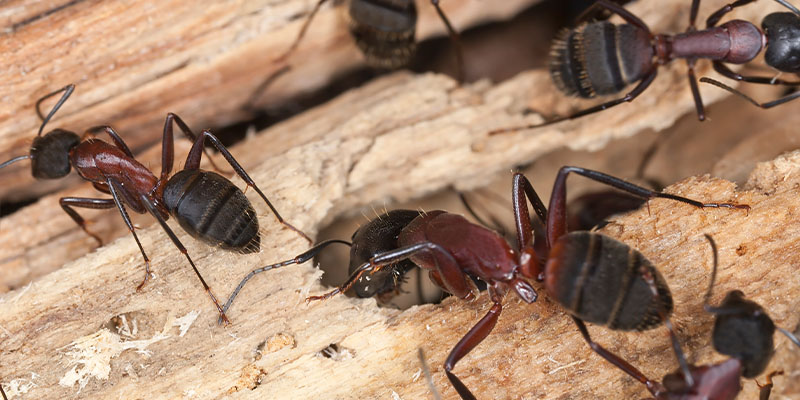Carpenter ants are notorious for their ability to cause significant structural damage to homes and buildings. These small insects can chew through wood, creating tunnels and galleries that weaken the structural integrity of a house. But just how fast can carpenter ants destroy a house?
In this informative and helpful article, we’ll delve into the behavior of these destructive pests, the factors that affect the speed of their damage, and what homeowners can do to prevent and address infestations. But first, let’s describe these pests in detail so you know how to tell them apart from other insects.
Carpenter ants are a common type of ant found in North America, and they are known for their wood-damaging habits. Here are some characteristics of carpenter ants:
Appearance
- Size. Carpenter ants are among the largest ants found in the United States, with workers measuring about 1/4 to 1/2 inch in length.
- Color. They are typically black, but some species may have a reddish or yellowish hue.
- Shape. Carpenter ants have a distinct, evenly rounded thorax and a single node between their thorax and abdomen.
- Wings. Winged carpenter ants, also known as swarmers, have two pairs of wings, with the hind wings shorter than the front wings.
Preferred Habitat
Carpenter ants prefer damp, decaying wood to build their nests. They are commonly found in forests, but they can also invade residential properties, especially if there is a moisture issue or decaying wood present.
Diet
Carpenter ants do not eat wood like termites; instead, they excavate wood to create their nests. Their diet consists of a wide range of plant and animal materials, including insects, honeydew, and other sugary substances. They also share the following traits:
- Attraction to residential properties. Carpenter ants are attracted to residential properties for several reasons – mostly for food, shelter, and water.
- Moisture. LIke other pests, carpenter ants are attracted to damp or moist wood, which is often found in areas with water leaks, poor ventilation, or damaged structures.
- Food. The presence of food sources, such as pet food, open trash cans, or food spills, can likewise attract carpenter ants to a property.
- Nesting opportunities. Decaying wood or wooden structures provide ideal nesting sites for carpenter ants.
Carpenter ants are large ants with a distinct appearance, preferring damp, decaying wood for their nests. Their diet consists of various plant and animal materials, and they are attracted to residential properties due to the presence of moisture, food sources, and nesting opportunities.
Summing it all up, carpenter ants are notorious for their ability to cause significant structural damage to homes and buildings. These small insects can chew through wood, creating tunnels and galleries that weaken the structural integrity of a house. But just how fast can carpenter ants destroy a house? Below, we’ll get into the nitty gritty of these destructive pests, the factors that affect the speed of their damage, and what homeowners can do to prevent and address infestations.
Factors Affecting the Speed of Carpenter Ant Damage
As you might imagine, there are several factors can influence the speed at which carpenter ants can destroy a house, including, but not limited to the following circumstances:
- Colony size. The size of the carpenter ant colony can have a significant impact on the speed of damage. Obviously, larger colonies can cause more damage in a shorter period than smaller ones.
- Moisture. As stated above, carpenter ants are attracted to damp or decaying wood, which is easier to chew through than dry wood. The presence of moisture can accelerate the damage caused by carpenter ants.
- Accessibility. The accessibility of the wood in a home can also affect the speed of damage. Carpenter ants can cause more damage in a shorter time if they can easily access the wood in a home, such as through gaps in the foundation or siding.
- Species. Different species of carpenter ants can cause varying levels of damage. For example, the black carpenter ant (Camponotus pennsylvanicus) is known for causing significant structural damage to homes.
Preventing and Addressing Carpenter Ant Infestations
Fortunately, homeowners can take several steps to prevent and address carpenter ant infestations:
- Eliminate moisture. Fix water leaks and improve ventilation to reduce moisture in and around the home.
- Seal entry points. Seal any cracks or gaps in the foundation, siding, or around windows and doors to prevent carpenter ants from entering the home.
- Remove decaying wood. Remove any decaying wood from the home and property, including old tree stumps or logs.
- Store firewood properly. Keep firewood away from the house and store it off the ground to prevent carpenter ants from nesting in it.
- Regular inspections. Regularly inspect the home for signs of carpenter ants, such as sawdust-like material (frass) or the presence of ants themselves.
- Call a professional. If an infestation is suspected, call a professional pest control company to assess the situation and develop a treatment plan.
Carpenter ants can cause significant structural damage to homes and buildings over time. The speed at which they can destroy a house depends on various factors, such as colony size, moisture, accessibility, and species.
Homeowners can take steps to prevent and address infestations, including eliminating moisture, sealing entry points, removing decaying wood, and regularly inspecting their homes. But, if an infestation is suspected, it is important to call a professional pest control company to assess the situation and develop a treatment plan. Homeowners should not attempt to deal with a carpenter ant infestation on their own for several reasons:
- Identification. It can be difficult for an untrained person to accurately identify carpenter ants and distinguish them from other ant species. Misidentification can lead to ineffective treatment methods and further damage to the property.
- Nest location. Carpenter ants often build their nests in hard-to-reach areas, such as inside walls, under floors, or in the attic. Locating and accessing these nests can be challenging for homeowners, and improper treatment may not eliminate the entire colony.
- Damage assessment. A professional pest control technician can assess the extent of the damage caused by carpenter ants and recommend the appropriate treatment plan. Homeowners may not be able to accurately assess the damage, which could lead to more extensive and costly repairs in the future.
- Treatment options. Pest control professionals have access to a variety of effective and safe treatment options, including baits, dusts, and sprays. Homeowners may not have access to these products or know how to use them properly, which could result in ineffective treatment or potential harm to the environment or household members.
- Prevention. A professional pest control company can provide advice on how to prevent future infestations, such as sealing entry points, reducing moisture, and eliminating potential nesting sites. Homeowners may not be aware of these preventive measures or do not address all issues, which could lead to recurring infestations.
As you can plainly see, it is crucial for homeowners to rely on an experienced pest control company when dealing with a carpenter ant infestation. Pest control professionals have the knowledge, experience, and tools to effectively identify, locate, and treat the infestation, as well as provide guidance on prevention measures to protect the property in the long run.

